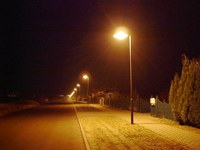Alpine landscape too bright at night
Swiss researchers have conducted a study to examine the extent to which man-made lighting has penetrated mountain regions since the 1970s. The comparison of satellite imagery shows that areas which previously were lit only in isolated spots - if at all - are now increasingly exposed to night time lighting.
The changes have been particularly visible in boundary areas of the Alps: at night Milan's metropolitan area and Switzerland's Mittelland in particular have almost become a sea of lights.
Between 1992 and 2000 alone the surface area affected by particularly strong lighting has doubled while the light intensity of the light sources has also increased. Reasons include the spread of motorisation and settlement areas as well as the growing trend in lighting for advertising or decorative purposes. Brighter nights affect not only the natural day-and-night rhythm of human beings but also the living conditions of many animals. And it is not just nature conservationists who are calling for darkness to be protected as a natural resource. Rising energy consumption is yet another aspect of this phenomenon.
Sources and information: http://saturn.unibe.ch/rsbern/publication/fulltext (en), www.nfp48.ch/projekte/projectdocs/3/FiatLux (de), http://saturn.unibe.ch/rsbern/publication/fulltext (Animation)
Between 1992 and 2000 alone the surface area affected by particularly strong lighting has doubled while the light intensity of the light sources has also increased. Reasons include the spread of motorisation and settlement areas as well as the growing trend in lighting for advertising or decorative purposes. Brighter nights affect not only the natural day-and-night rhythm of human beings but also the living conditions of many animals. And it is not just nature conservationists who are calling for darkness to be protected as a natural resource. Rising energy consumption is yet another aspect of this phenomenon.
Sources and information: http://saturn.unibe.ch/rsbern/publication/fulltext (en), www.nfp48.ch/projekte/projectdocs/3/FiatLux (de), http://saturn.unibe.ch/rsbern/publication/fulltext (Animation)
